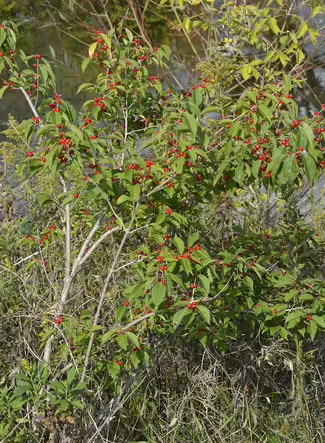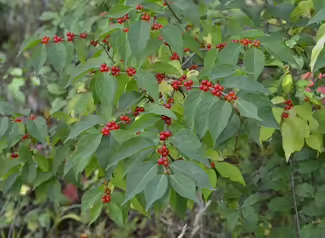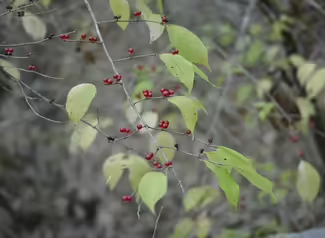
Invasive Amur Bush Honeysuckle
Amur Bush Honeysuckle, Lonicera maacki, is a widespread invasive across the Midwest. This shrub grows quickly and starts growing before native plants in the spring, giving it a competitive advantage, and seeds are easily spread by birds. Bush honeysuckle describes a family of shrub-like honeysuckles. The most common invasive honeysuckles in Illinois are Tartarian (Lonicera tatarica), Amur (L. maacki), and Morrow (L. morrow).
Amur Bush Honeysuckle Damage
Amur honeysuckle is a bush honeysuckle that forms dense thickets. It displaces native vegetation and makes it difficult for species that require a lot of light to survive in the understory. It leafs out early in the spring before other plants green up, allowing it to compete for resources earlier than other plants.

Amur honeysuckle was introduced in 1898 as an ornamental plant. It was also planted to assist with erosion control and to serve as habitat for wildlife.
Regulation of Amur Bush Honeysuckle
Amur honeysuckle is regulated under the Illinois Exotic Weed Act. It cannot be sold or distributed.
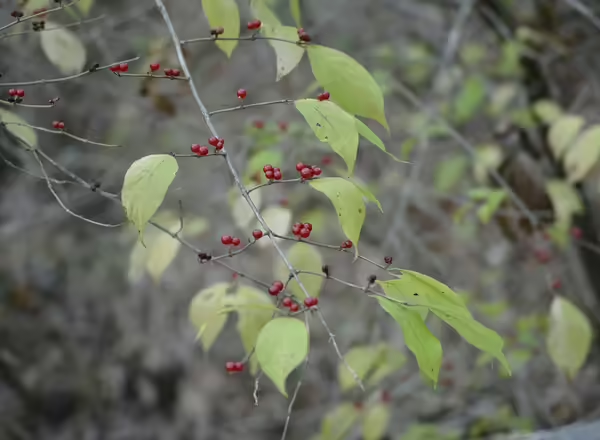
Amur honeysuckle is a woody shrub that can grow in full sun and the shade of woodlands. The best way to find bush honeysuckle is to look in the woods in the late fall or early spring where it can form dense thickets. It can grow over 15 feet tall. The bark is striated, and the shrub is often multi-stemmed. Its leaves are oppositely arranged, and rather oval in shape. The tips of the leaves taper to a point. When in bloom, amur honeysuckle produces paired white flowers in late May to early June. The flowers are replaced with round, red berries that ripen in the fall.
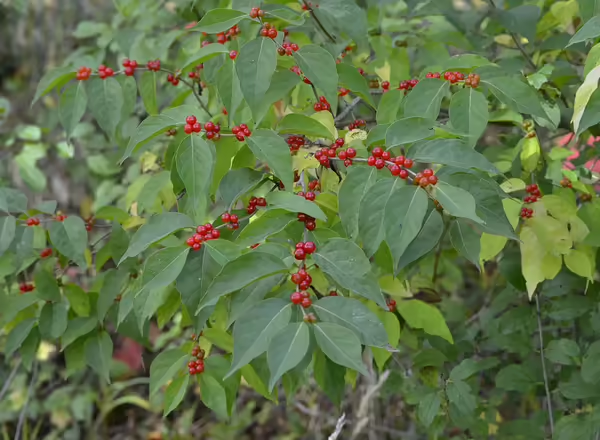
The following control recommendations for Amur honeysuckle are also effective for other invasive bush honeysuckle species in Illinois.
- Mechanical removal: Amur honeysuckle root systems are shallow. Young plants can be pulled from the ground when the soil is moist. The use of a grubbing tool can aid in pulling larger plants.
- Fire: Prescribed fire may kill seedlings but generally not large plants. If impacted, plants may be stunted or may not produce seeds in the year after a fire.
- Chemical control: Always read and follow the herbicide label before initiating treatment.
- Foliar: Apply 2% to 4% volume-to-volume (v/v) glyphosate in water.
- Basal bark: Plants 4 inches in diameter or less—apply a triclopyr ester formulation at a 20% to 30% v/v rate, mixed with basal oil, to the lowest 15 inches of the stem.
- Cut stump: Apply glyphosate at a 25% to 50% v/v rate in water (*preferred) or triclopyr amine in water or ester in oil at a 20% to 25% v/v rate within 10 minutes of cutting. If seeds are present on the plant, take care not to spread them during control.
For more information, explore Management of Invasive Plants and Pests of Illinois.
Bush honeysuckle species (Lonicera maackii, L. tatarica, L. morrowii, L. x bella) are significant invaders in Illinois’ forested ecosystems. Controlling bush honeysuckle can be very effective in winter. While some leaves and berries may persist into winter, other characteristics are...
When people think of honeysuckle control many will reach for the saw or herbicide. But young honeysuckle has a very shallow root system that makes it easy to pull up by hand. In this video horticulture educator Chris Enroth with Illinois Extension demonstrates the ease of hand removal of young...
